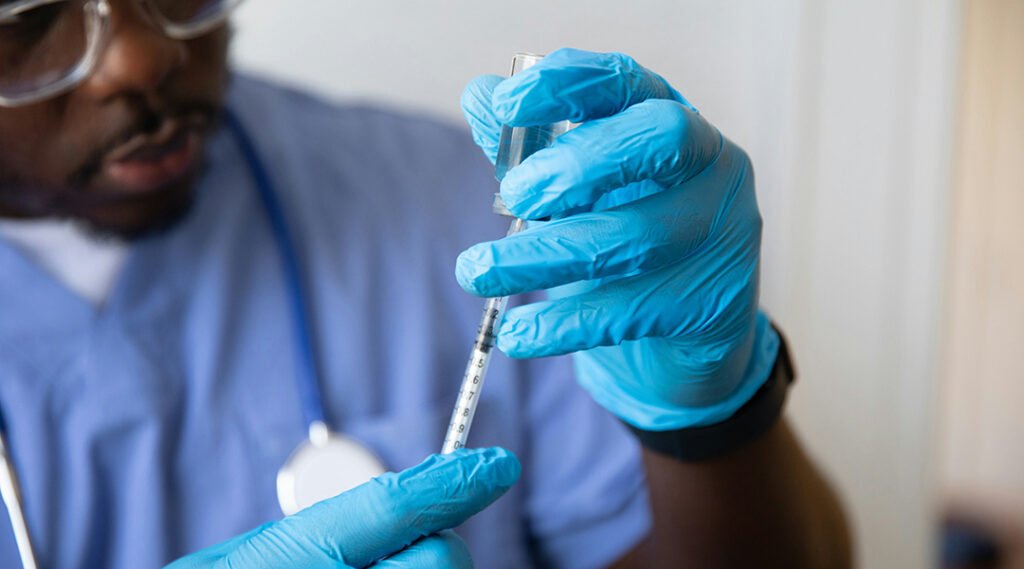Researchers are using a new technique to increase the effectiveness of protein subunit vaccines (vaccines that use harmless fragments of viruses or bacteria to trigger an immune response) while reducing the need for immune-enhancing molecules called adjuvants. We are rethinking vaccine design.
Vaccines expose the immune system to an antigen (usually a protein from a pathogen or an inactive form of a virus or bacteria) so that immune cells can recognize it and quickly mount a defense against future exposure.
Modern vaccines also contain adjuvants that further stimulate immune cells and increase the overall effectiveness of the vaccine.
One widely used adjuvant is CpG. This is a set of genetic material found in many pathogens but not in humans. However, when CpG is used in inhaled vaccines, it can cause severe reactions in the respiratory tract.
This method significantly reduces the required dose of CpG compared to traditional approaches by directly conjugating protein subunits with adjuvants called CpG oligodeoxynucleotides. The researchers say this breakthrough could improve the efficiency and safety of subunit vaccines such as HPV and hepatitis B.
“We believe that to develop inhaled vaccines containing CpG adjuvants, it is necessary to reduce the dose of CpG adjuvants to reduce side effects,” said Li Zhu, a researcher at the Beijing Institute of Biotechnology. .
Vaccines that are more effective at lower doses
Strengthening your defenses against pathogens at the point of entry greatly increases your body’s chances of fighting off the invaders. For respiratory pathogens such as influenza and SARS-CoV-2, this battleground is the mucosal cells of the lungs.
Reaching these cells with an aerosolized inhaled vaccine is the best way to provide this protection, but common vaccine ingredients can cause an immune system overreaction in lung cells. Adjuvants and antigens are usually mixed separately into vaccines. That is, some cells take up both components, while others take only one or the other.
Zhu et al. set out to overcome the challenge of lowering the dose of adjuvants without losing their performance-enhancing effects. Their strategy was to combine antigen and adjuvant so that immune cells could encounter and take up both at the same time.
“By combining antigen and adjuvant and ensuring that they enter the same cell, we can reduce the dose of adjuvant,” said team member Qiao Pan of the Beijing Institute of Biotechnology. . “This method not only ensures vaccine efficacy, but also reduces the dose of adjuvant and increases safety.”
However, it’s a little more complicated than simply joining two molecules together. If the shape and location of the binding are not considered, critical sites where the vaccine and cells need to bind can be blocked, reducing the effectiveness of the platform.
“A good analogy is that the antigen acts as a template for antibody production. If the mold is in the wrong shape, the antibodies will not be produced correctly,” explained team member Hengliang Wang. Size is also a consideration, and the entire package must be large enough to fit into the cell without further packaging.
Precisely joining these components together without the need for complex chemical reactions, which can be time-consuming, costly, and produce unintended byproducts. The team used what is essentially a “biological glue” called the Spy-Catcher/SpyTag system.
Using this new technique, the researchers could easily attach a catcher to one molecule and tag another. The catcher and tag bind to each other at specific positions, effectively creating the desired binding molecule. The researchers attached the catcher to several antigens, but needed another link in the chain to attach the CpG to the tag molecule.
Build from another platform
Here, the research team drew inspiration from known cancer treatments. This treatment is also designed to seek out specific cells, in this case the tumor, and trigger an immune response. The treatment has three components: a clump of DNA that finds and binds to tumor cells, an immune system protein that tells the body to attack the tumor, and a protein called DVC that connects the two.
“The concept of using DCV to join two functional molecules inspired our research,” Zhu said.
They similarly used DVC to attach a DNA strand, a CpG adjuvant, and then used the SpyCatchter/SpyTag system to attach DVC to the antigen. This combination of tools met the criteria of being easy to run a series of reactions and producing small enough products to enter the cell together.
“By using DCV to connect the adjuvant and antigen, we were able to shorten the distance between them, allowing immune cells to take up both components at the same time,” Zhu explained. .
In clinical tests, the research team confirmed that the vaccine components were binding in the correct locations, forming the desired antigen-adjuvant complex. According to Zhu, this method “reduces the amount of adjuvant needed and improves the safety of inhaled vaccines, especially those using CpG adjuvants.” Additionally, the method ensures site-specific binding and Maintain correct structure. ”
The system is also suitable for high-volume production due to efficient and easy-to-use components such as Spy and DVC that produce a uniform product every time.
“Dosage form research is the next focus of our work,” says Zhu. The team is working on aerosolized or powdered forms to evaluate different dosages and efficiencies. “Ultimately, we aim to test this system in primates and put this vaccine system into clinical use.”
Reference: Yange Sun et al., Click Enzyme Method for Antigen-Adjuvant Binding, Small Methods (2024). DOI: 10.1002/smtd.202401116
Feature image credit: Unsplash

